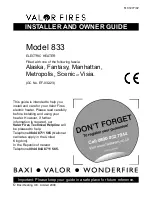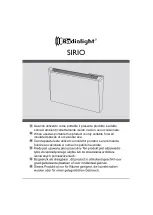
4
IMPORTANT OPERATING INSTRUCTIONS
not attempt to defeat this safety feature.
40. DO NOT block air intakes or exhaust
in any manner. Do not place on soft
surfaces, like a bed, where openings may
become blocked.
41. DO NOT depend on the on/off switch
as the sole means of disconnecting power
when servicing or moving the heater.
42. Make sure room is equipped with a
working smoke detector.
43. This heater is not suitable for use in
hazardous locations. Please refer to
National Electric Cod (NEC) Article
500 or applicable state or local codes
or standards relating to electrical
requirements for Hazardous locations.
44. This heater does NOT meet the
requirements of NEC article 500 (2008).
45. DO NOT insert or allow foreign objects
to enter any ventilation or exhaust
opening as this may cause an electric
shock or fire, or damage the heater.
46. SAVE THESE INSTRUCTIONS.
ASSEMBLY INSTRUCTIONS
Set up Bag Enclosure
1. Remove PackTite enclosure (and shelf),
heater and heater box from the box and
remove all packaging materials (plastic
cover, bubble wrap, etc.).
2. Unfold the bag so that the vent is on top
and the heater bracket is facing to the
right.
3. Place the unit on a firm, level surface and
at least 3 feet away from walls, furniture,
curtains, plants or combustible materials.
4. Unzip the top flap and shift or adjust
the shelf so that the bottom of each leg
sits firmly in the bottom corner of the
enclosure.
5. Pull up the support bar on each side of
the shelf to an upright position until the
metal guides on either side lock into place
just on top of the shelf.
6. Position the unit so that the “PackTite”
logo is facing to the front.
Attach Heater
1. Attach the heater housing to the opening
window frame for the heater by hooking
the bottom metal clip underneath the
window frame and hooking the two side
clips around each side of the window
frame.
Opening for
the heater
<ebilÛm[^abg]ieZlmb\
bg]hhkhg[hmmhf
Zg]^Z\alb]^'
Heater
Housing
Clips
2. Insert heater into the heater housing from
the top.
3. The heater should sit level inside the
housing with the front touching the
placement bracket
4. The front of the heater should face
towards the enclosure and the cord should
be extended from the back of the heater
out of the heater housing.
5. Plug the heater cord directly into the wall
outlet.
Load and Operate
1. Place items to be treated on the shelf and
distribute evenly.
2. Take care not to overfill the unit. For
proper operation, items should not extend
beyond the orange strips on either side
of the shelf or above the height of the
support bar. DO NOT BLOCK THE
VENT.
3. When treating luggage, open luggage
top and unzip any pouches or exterior
compartments to allow heat to circulate
through the interior. When treating
personal items (purses, backpacks, etc.)
open or unzip any interior or exterior
compartments.
4. This unit comes with a thermometer/
timer device. Place the thermometer
probe inside any item to be monitored
(pocket, shoe, suitcase, etc.). Zip the top
flap closed with the thermometer cord
extending out the upper corner of the flap.
Be careful to not zip the flap too tightly.
This will damage the thermometer cord
and reduce the life of the device.
5. Set both controls on the heater to the
highest settings (heat and air flow).
Shut Down Procedure
1. When finished with a treatment cycle,
leave the airflow setting on HIGH and
turn the heat setting to FAN. Unzip the
top flap and run in this manner for at
least 10 minutes.
2. Turn the heater controls to OFF, unplug
the heater, unzip the top flap and remove
contents.
ASSEMBLY INSTRUCTIONS
TROUBLE SHOOTING TIPS
If the heater shuts off unexpectedly or fails
to operate, the above-mentioned safety
feature may have been activated to prevent
overheating.
1. Be sure the power cord is plugged into a
working electrical outlet.
2. Make sure the circuit breaker or fuse is
working properly.
If the heater runs for several minutes
and shuts off repeatedly, the heater is
overheated.
a. Make sure the back of the unit (heater
end) is at least 3 feet from any object.
b. Make sure the contents being treated
are not blocking air from exiting the vent
in the top of the enclosure
5






















